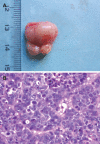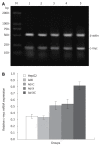Biological impact of hepatitis B virus X-hepatitis C virus core fusion gene on human hepatocytes
- PMID: 18803352
- PMCID: PMC2744172
- DOI: 10.3748/wjg.14.5412
Biological impact of hepatitis B virus X-hepatitis C virus core fusion gene on human hepatocytes
Abstract
Aim: To investigate the biological impact of hepatitis B virus X- hepatitis C virus core (HBV X-HCV C) fusion gene on hepatoma cells.
Methods: The recombinant adenoviruses Ad-XC, Ad-X and Ad-C expressing HBV X-HCV C fusion gene, HBV X gene and HCV C gene were constructed, respectively. Hepatoma cells were infected with different recombinant adenoviruses. MTT, colony-forming experiment, FCM, TUNEL assay were performed to observe the biological impact of the HBV X-HCV C fusion gene on liver cells.
Results: MTT showed that the Ad-XC group cells grew faster than the other group cells. Colony-forming experiment showed that the colony-forming rate for the Ad-XC group cells was significantly higher than that for the other group cells. FCM analysis showed that Ad-XC/Ad-X/Ad-C infection enhanced the progression of G1-->S phase in the HepG2 cell cycle. The apoptosis index of the Ad-XC, Ad-X, Ad-C group cells was significantly lower than that of the Ad0 and control group cells. Semi-quantitative RT-PCR showed that the expression level of c-myc was the highest in Ad-XC infected cells. Tumor formation was found at the injected site of mice inoculated with Ad-XC-infected LO2 cells, but not in control mice.
Conclusion: Ad-XC, Ad-X and Ad-C facilitate the proliferation activity of HepG2 cells and inhibit their apoptosis in vitro. The effect of Ad-XC is significantly stronger than that of Ad-X and Ad-C. Up-regulation of c-myc may be one of the mechanisms underlying the synergism of HBV X and HCV C genes on hepatocarcinogenesis in athymic nude mice.
Figures






Similar articles
-
Hepatitis B virus and hepatitis C virus interaction in Huh-7 cells.J Hepatol. 2009 Sep;51(3):446-57. doi: 10.1016/j.jhep.2009.04.025. Epub 2009 Jun 3. J Hepatol. 2009. PMID: 19596477
-
[Biological impact of the COOH-terminal 40 amino acid deletions of hepatitis B virus X protein in hepatocellular carcinoma cells].Zhonghua Yi Xue Za Zhi. 2005 Mar 30;85(12):825-30. Zhonghua Yi Xue Za Zhi. 2005. PMID: 15949399 Chinese.
-
Hepatitis B virus X protein promotes human hepatoma cell growth via upregulation of transcription factor AP2α and sphingosine kinase 1.Acta Pharmacol Sin. 2015 Oct;36(10):1228-36. doi: 10.1038/aps.2015.38. Epub 2015 Jun 15. Acta Pharmacol Sin. 2015. PMID: 26073327 Free PMC article.
-
Molecular mechanistic insight of hepatitis B virus mediated hepatocellular carcinoma.Microb Pathog. 2019 Mar;128:184-194. doi: 10.1016/j.micpath.2019.01.004. Epub 2019 Jan 3. Microb Pathog. 2019. PMID: 30611768 Review.
-
[Molecular mechanism of hepatocarcinogenesis].Gan To Kagaku Ryoho. 1999 Dec;26(14):2154-61. Gan To Kagaku Ryoho. 1999. PMID: 10635298 Review. Japanese.
Cited by
-
Concurrent infection of hepatitis B virus negatively affects the clinical outcome and prognosis of patients with non-Hodgkin's lymphoma after chemotherapy.PLoS One. 2013 Jul 8;8(7):e69400. doi: 10.1371/journal.pone.0069400. Print 2013. PLoS One. 2013. PMID: 23861969 Free PMC article.
-
[Analysis of clinical characteristics and prognostic factors in patients with non-Hodgkin lymphoma and HBV infection].Zhonghua Xue Ye Xue Za Zhi. 2018 Jul 14;39(7):563-568. doi: 10.3760/cma.j.issn.0253-2727.2018.07.007. Zhonghua Xue Ye Xue Za Zhi. 2018. PMID: 30122015 Free PMC article. Chinese.
References
-
- Horton RM, Hunt HD, Ho SN, Pullen JK, Pease LR. Engineering hybrid genes without the use of restriction enzymes: gene splicing by overlap extension. Gene. 1989;77:61–68. - PubMed
-
- Zarski JP, Bohn B, Bastie A, Pawlotsky JM, Baud M, Bost-Bezeaux F, Tran van Nhieu J, Seigneurin JM, Buffet C, Dhumeaux D. Characteristics of patients with dual infection by hepatitis B and C viruses. J Hepatol. 1998;28:27–33. - PubMed
-
- Donato F, Boffetta P, Puoti M. A meta-analysis of epidemiological studies on the combined effect of hepatitis B and C virus infections in causing hepatocellular carcinoma. Int J Cancer. 1998;75:347–354. - PubMed
MeSH terms
Substances
LinkOut - more resources
Full Text Sources

